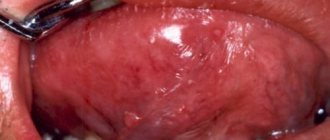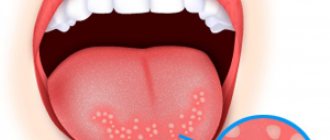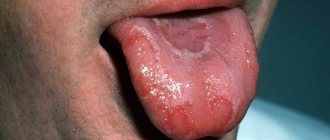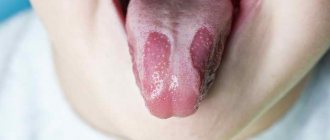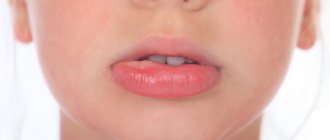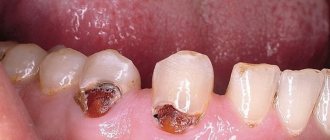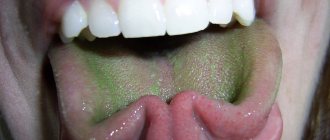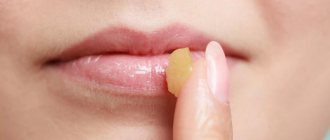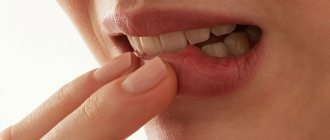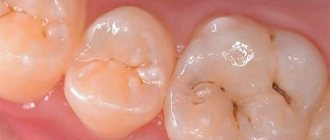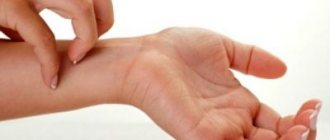The oral mucosa is susceptible to infection and inflammation due to the many microbes present here. Most often, complications arise due to decreased immunity. That is why various blisters on the gums and other parts of the oral cavity should alert a person and force them to seek professional advice and treatment. Small blisters and almost invisible rashes occur with dangerous viruses, and if left unchecked they can cause many problems.
Description
This unpleasant phenomenon can affect both adults and children, causing discomfort and pain when eating.
The appearance of white blisters on the gums as a result of damage to the oral mucosa contributes to burning and itching; such symptoms are especially painful for young patients.
It is not for nothing that experts say that the condition of the oral cavity is a kind of mirror that reflects the state of human health. You can provide first aid in the presence of such a pathology at home using traditional methods.
After treatment, preventive measures are required to prevent the recurrence of blisters on the gums. Externally, they appear as small transparent or white blisters, which are located in various places of the oral mucosa. Most often they appear in small groups. The inflamed areas become covered with a characteristic white or yellow coating.
Thermal
Such damage includes microtraumas resulting from drinking too hot tea or coffee.
The duration of wound healing from thermal exposure directly depends on the depth of the lesion; they take quite a long time to heal.
Depending on the degree of damage, sensations change:
- In the first degree, the burn occurs only on the outer layer of the tongue. A person experiences pain, the color of the tongue changes to red and after some time begins to swell. Rinsing the mouth with antiseptic solutions will help speed up the healing process.
- In the second degree, the sensations become more painful, since not only the outer but also the inner layer of the tongue is affected. The formation of blood blisters, swelling of the tongue and its redness are also observed. In this case, it is recommended to seek medical help as soon as possible so that the doctor removes the lump, washes the affected area and treats it with an antiseptic.
- In the third degree, the burn penetrates deep into the tongue, the burned surface becomes black. The patient complains of a feeling of numbness of the tongue and severe pain. The help of a doctor is mandatory here, otherwise there is a high probability of death.
We suggest you familiarize yourself with Blisters on the tongue closer to the throat than to treat
Why do adults get blisters on their gums?
A person’s mouth constantly contains a large number of pathogenic organisms and microbes. Even with daily high-quality cleaning and proper care, the ideal balance is not achieved. Doctors, not without reason, consider the internal mucous membranes and tongue to be the dirtiest areas. Viruses easily enter the body when a patient coughs or talks, through the air or through the nasopharynx.
Blisters on the gums very often appear in the oral cavity. This rash looks like a soft lump that is filled with fluid. Its color can be whitish or pink; it turns brown due to impurities of pus or blood.
Outer
- Herpes – the virus of this disease leads to the formation of blisters filled with liquid of different sizes and locations. Often, blisters appear in groups and are accompanied by hyperemia, itching and slight pain.
- Blisters can appear as a result of illness, as a result of accidental injury, which can occur as a result of:
- Talking while eating;
- Incorrect bite;
- Contact with acid;
- Thermal burns;
- Incorrect installation of dentures.
First signs
The first signs of blisters in the mouth:
- tingling, burning and itching in the mouth;
- the occurrence of pain;
- discomfort while chewing food;
- slight tissue swelling;
- dry mouth.
Based on external symptoms, the dentist can guess what caused the appearance of tumors on the mucous membrane:
- various microorganisms, fungi, infections;
- autoimmune conditions (chronic tuberculosis, hepatitis, HIV);
- allergies to food or drugs;
- consequences of a mouth burn from a hot drink or food;
- advanced conditions of periodontal disease, caries or pulpitis;
- exacerbation of inflammation of internal organs.
The dentist can make a more accurate diagnosis based on laboratory analysis of scraping the contents of the vesicle and the mucosal surface. The cause of blisters on the gums in half of the cases is the herpes virus.
Medical statistics say that active manifestations of this disease are observed in 80-90% of patients of different ages. Symptoms of the initial form or permanent relapse are most often diagnosed in children of the first year of life and elderly people with a weakened body.
Blisters in the mouth: causes, diagnosis, treatment, explanations and dental advice
The mucous membranes in the oral cavity are susceptible to the development of primary dermatological diseases. Such pathologies manifest themselves in different ways, but they all have a number of characteristic features. Dentistry studies these manifestations, and in some cases, specialists are able to diagnose the disease before symptoms appear on the mucous membrane.
One of the common pathological manifestations encountered in dental practice is blisters in the mouth on the roof of the mouth, on the cheeks and even on the lips. This symptom is an alarming signal and requires examination to identify the cause of this manifestation. Blisters can occur in patients of all ages. Having an identical clinical picture, they indicate different viruses and infections.
Signs
A characteristic feature of blisters in the mouth is their short lifespan. As a rule, they quickly open after appearance, and erosion forms in their place.
In this case, the mucous membrane left without the upper protective layer can be exposed to various pathogenic microorganisms that are constantly present in the oral cavity.
Thus, the first symptoms of dental diseases, such as stomatitis, appear, and the pain of erosion also worsens. A person in this state cannot sleep or eat normally.
A blister in the mouth is a cavity element that reaches 5 mm in diameter. It occurs as a result of the accumulation of any liquid at the site of damage.
The most common disease, which is characterized by the formation of blisters on mucous membranes or non-inflamed skin, is called pemphigus.
Without timely treatment, this pathology tends to affect large areas of the skin and mucous membranes, and over time it can degenerate into a malignant neoplasm.
Pemphigus refers to a number of diseases of the mucous membranes, which are accompanied by the formation of vesicular rashes, but with various clinical indicators, such as the presence of acantholytic cells in smears.
At the initial stage, the disease is most often localized in the oral cavity, which leads to erroneous diagnoses and the prescription of incorrect treatment.
Varieties
Pemphigus is divided into the following varieties:
- True, or acantholytic.
- Vulgar.
- Vegetative.
- Leaf-shaped.
- Seborrheic, also called erythematous.
- Senir-Usher syndrome.
- False, or non-acantholytic.
- Strophic, mucosineachial, bullous dermatitis.
- Lever's pemphigoid of the bullous type.
- Benign non-acantholytic.
Risk factors
Damage to the oral mucosa by a viral infection is an unpleasant and painful phenomenon. The factor that provokes the appearance of blisters on the roof of the mouth is a disease called “viral stomatitis.”
This is a common type of infectious lesion that occurs as a result of several pathologies, including:
- Chicken pox.
- Herpes simplex virus.
- Flu.
- Parainfluenza.
- Adenovirus and other factors
An allergic reaction, infection, and injury can also cause mouth blisters to appear on the cheek.
Risk factors may also include vitamin deficiency, disorders of the cardiovascular and endocrine systems, diseases of the gastrointestinal tract, etc.
In addition, hematological diseases and intoxication of the body, especially with heavy metal poisoning, can lead to this unpleasant phenomenon.
Causes
In some cases, blisters in the mouth indicate the presence of serious diseases that occur in a latent form. Most often we are talking about the following pathologies:
1. Herpangina. It affects the oral cavity and nasopharynx quite intensively. Characterized by increased body temperature, pain during swallowing, and loss of appetite. In some cases, diarrhea appears.
Blisters initially look like red spots, but later transform into blisters with clear liquid inside. A possible complication of herpangina can be pathological damage to the meninges, as well as the liver and heart.
However, the cause of blisters in the mouth must be determined by a doctor.
2. Herpes. The vast majority of the inhabitants of our planet are carriers of the herpes virus. At the time of relapse, the symptoms of the disease have characteristic features. The affected area begins to itch, burning and redness occur. A day later, transparent blisters with a yellowish liquid inside form.
3. Afta. As a rule, the appearance of aphthous ulcers is a consequence of complications after oral diseases. However, aphthae also occurs quite often as an independent disease. The pathology is characterized by severe pain, especially during chewing and swallowing, high body temperature, and enlarged lymph nodes.
4. Shingles. Nerve fibers are affected. The disease is localized at the site of infection and is accompanied by a deterioration in the general condition, elevated temperature, etc. Some time later, swelling forms on the affected areas of the skin, which later transforms into transparent blisters. Then the liquid in the blisters becomes cloudy.
5. Mechanical damage. The most common cause of blisters in the mouth is improperly fitting dentures. It could also be an allergic reaction to medications or a burn to the mouth from hot food or drink.
What does a blood blister in the mouth mean? Such a bubble can appear while eating or talking and accidentally biting. The mucous membrane can also be injured:
- from hard foods: candies, crackers, bones;
- from broken, chipped teeth or incorrectly made dental structures: braces, bridges, crowns, dentures;
- During hygiene procedures, due to careless movements, tissues are damaged during brushing.
Clinical course of the disease
All of the above factors and diseases are accompanied by the manifestation of a number of characteristic symptoms. If a blister pops up in the mouth, then this will be considered a symptom common to all pathologies. Small blisters can be localized on the tongue, cheeks and gums. Inside the blisters there is serous exudate.
General symptoms
The usual symptoms of the disease may be absent. The acute stage of the pathology may be accompanied by symptoms such as:
- General malaise.
- Weakness.
- Slight increase in body temperature.
- Enlarged lymph nodes.
- Swelling and redness of the mouth.
- Single or multiple bubbles.
- Erosion at the site of broken blisters.
- Loss of appetite.
- Difficulty chewing and swallowing food.
- Aching pain, itching and burning.
- Bad breath.
Diagnostics
Before you begin oral treatment, you should conduct an examination and clarify the diagnosis, identifying the root cause of the blisters. To do this, you can visit both a dentist and a dermatologist. A consultation with a general practitioner would also be helpful.
Diagnostic measures involve taking the patient's medical history, as well as a physical examination and laboratory tests. To clarify the diagnosis, a smear of the contents of one of the vesicles is taken. Next, a study is carried out and the causative agent of the disease is identified. This is the most effective diagnostic method in this case.
Experienced specialists can determine the diagnosis based on clinical indicators, without the use of additional methods. However, a laboratory test will confirm the diagnosis and allow you to prescribe the correct treatment.
What to do when blisters appear in your mouth?
Treatment at home
Complete treatment at home is impossible. It is imperative to consult a specialist and follow the recommendations prescribed by him.
However, if it is not possible to immediately go to the doctor, you can use several methods to relieve the condition on your own. For example, you can start rinsing your mouth with a soda solution or herbal decoction.
Rose hips and chamomile, which have anti-inflammatory and antimicrobial effects, are best suited for these purposes. It is also good to use propolis tincture.
You can combine traditional methods of treatment with traditional medicine. However, it is also advisable to discuss this option with your doctor. Especially when it comes to blisters in a child’s mouth.
There are quite a few recipes that help solve various problems. Most often, it is recommended to use herbal preparations that will help relieve inflammation and swelling or have an antiviral effect.
Aloe or Kalanchoe
These indoor plants can also become helpers in the fight against blisters on the mucous membranes of the mouth. Plants should be used in the form of lotions. To do this, cut off a leaf or a small part of it, peel it and apply it to the affected area. After a few minutes, the cut is renewed to release fresh juice.
Conservative treatment
The main goal of treating blisters in the mouth is to completely eliminate the factor that led to their formation. Therefore, simultaneously with symptomatic treatment, therapy for the underlying disease is carried out. The duration of treatment can range from two weeks to one month. The treatment regimen depends on the diagnosis:
- Aphthae are treated using local drugs (antiviral, antiseptic and wound healing).
- The infection will require complex treatment, including antibiotics. Rinsing with special solutions is also allowed.
- Antifungal medications will be needed to treat candidiasis. You can use sprays, ointments and solutions to apply to erosions.
- Herpes in a recurrent form requires taking antiviral drugs orally. It is important to start treatment at the very beginning of the disease, namely in the first day after symptoms are identified. Sometimes, for herpes, anesthetics are prescribed that protect the mucous membranes of the mouth.
- Pemphigus is an autoimmune disease. Its treatment involves taking corticosteroid drugs. Various immunomodulatory drugs and vitamin complexes are also prescribed.
Complications
Blisters in the mouth themselves cannot cause complications. However, lack of treatment can lead to suppuration and more extensive lesions of the mucous membrane. All this will cause unpleasant and uncomfortable sensations, affecting a person’s quality of life. Consequences can occur if the root cause of the blisters is not treated.
Prevention of this pathology
Preventive measures directly depend on the causes of the blisters. However, there are a number of preventive rules common to any disease:
- Maintaining personal oral hygiene.
- Timely treatment of any pathologies localized in the mouth.
- Washing hands with soap before eating.
- Choosing the right toothbrush that will not injure your gums.
- Supplementing your daily diet with fresh berries, fruits and vegetables.
Thus, the most important point in the treatment of blisters in the mouth is the timely determination of the cause that caused such a symptom.
Source: https://FB.ru/article/387662/voldyiri-vo-rtu-prichinyi-diagnoz-lechenie-razyyasneniya-i-sovetyi-stomatologa
Characteristic sign of herpes
A characteristic feature of oral herpes is a sudden jump in temperature. The patient feels severe weakness in the lower extremities, lack of appetite and a desire to sleep. Small blisters with clear or cloudy liquid appear on the inside of the cheek or gum. These areas hurt when touched, and they burn when eating. After a few days, they open and bright red wounds form. If treated incorrectly, the rash reoccurs and begins to spread to the larynx and palate. This is fraught with severe complications for humans.
Other diseases
Another pathology that requires the patient’s attention and comprehensive medical supervision is viral pemphigus, which occurs when there is a sudden deterioration in the immune system after tonsillitis, flu or tonsillitis. This problem often complicates the life of cancer patients, occurring after chemotherapy in the mouth. It begins with the appearance of small white blisters on the gums, gradually moving to the inside of the lip, palate and throat. Pemphigus, like herpes, covers the mucous membrane completely, provokes high fever and weakening of the body due to intoxication. Translucent oral blisters can be found on the patient's head and body.
Often in adult patients, a blister appears after tooth extraction. This is primarily due to violation of sterilization standards for instruments. During a minor dental operation, a dentist may introduce bacteria into the wound. At the root, the process of inflammation begins and a cyst filled with purulent exudate is formed. The amount of pus gradually increases, and a blister appears on the gum.
Blood blisters on or inside the cheek
The main cause of blood blisters on the inside of the cheeks is friction against sharp or ingrown teeth when you eat. Gentle rubbing usually results in the formation of a painless blood blister on the inside of the cheeks.
We suggest you familiarize yourself with Dry mouth, shortness of breath, dizziness
In case your teeth are very sharp, you can fix them through dental surgery by cutting off the sharp ends. Otherwise, you will often bite or rub them on your inner cheeks and cause injuries, which may lead to blood blisters from time to time. In some cases, you You may bite your cheek when speaking or chewing food.
Super plant Kalanchoe for acne!
Reasons for the appearance of bubbles on the gums of a child
Due to its age, the child’s body does not have stable immunity and is not able to adequately resist viral diseases. A watery bump may indicate scarlet fever, measles or chickenpox. Stomatitis is especially common in children - a fairly common process of inflammation of the oral mucosa caused by candida fungi. It is characterized by the following symptoms:
- the appearance of blisters on the gums, as well as on the inner surface of the cheeks or lips;
- erosions that do not heal well;
- itching and burning in the mouth, exhausting the child;
- chills and fever;
- whitish coating on the palate and tongue;
- weakness and drowsiness.
The disease is easily transmitted through dirty household items, toys, and food, so dentists tell parents about the importance of observing all hygiene standards. At the initial stage, inflammation can be quickly stopped, and complications will be excluded.
Another problem for young patients is difficulty in cutting baby teeth. Often, before a molar or incisor appears, a small compaction filled with ichor forms on the gum. The doctor will sometimes gently open the blister to relieve pain and discomfort. With proper care, the wound will heal in a few days, and all unpleasant sensations will completely disappear.
First aid
Small blisters on the gums, of course, need to be dealt with with the help of a doctor who will make a diagnosis and determine the real cause of the formations in the mouth. Regardless of the number and size of the bubbles, immediate contact with a specialist is required.
As first aid, it is allowed to use antiseptics, pharmaceuticals, disinfecting ointments and special solutions that need to be used to rinse the mouth. These drugs will soothe the mucous membrane, reduce irritation and reduce pain.
This effect can be achieved by using traditional medicine methods.
Treatment of blisters
You can get rid of blisters on the gums near the tooth if the diagnosis was made correctly by an experienced doctor. Therefore, there is no need to delay your trip to a specialist and lead the pathology to significant complications, risking your own health and loss of teeth. For a blister on the gum caused by a recurrence of herpes infection, the patient is prescribed several therapeutic measures:
- taking antiviral drugs orally (Akiclovir);
- immunity is strengthened through a vitamin complex, aloe vera extract and a course of immunoglobulins;
- a special diet with a reduced content of sweet and rich foods, fats and canned food;
- treating wounds after a blister breaks with antiseptic and healing agents: Metrogyl Denta, Chlorophyllipt, Cholisal.
For rashes due to candidiasis, therapy is based on the use of antifungal drugs. The oral cavity and gum blister are lubricated with a solution of Candida, Decamine or nystatin ointment. For treatment of stomatitis to be effective, the patient needs to take a course of Amphoterecin and Clotrimazole tablets. A good way to remove plaque in the mouth and fight itching is by rinsing with plain soda, which is diluted in warm water.
If there is severe pain due to a bubble on the gum and it is impossible to rest or eat, dentists recommend treating this area with antiseptic ointments. They contain anti-inflammatory substances and gently freeze the nerve endings for several hours. Moreover, most of them can be used to treat children to eliminate discomfort during teething: “Pansoral”, “Kamistad”, “Cholisal”, “Kalgel”.
How else to treat blisters on the gums of an adult and a child?
Pemphigus
A flaccid transparent bubble has appeared in the mouth, what is it? This may be a manifestation of an autoimmune pathology - pemphigus. It most often affects people over 50 years of age. There are several types of disease:
- Pemphigus vulgaris is manifested by the formation of complete blisters, candidiasis may occur, and a white cheesy coating will appear. A specific smell appears in the mouth. Later the rash spreads throughout the body.
- Pemphigus foliaceus. After opening, the blisters become covered with lamellar crusts, under which new rashes constantly form. A thick layer of crusts forms. If infection occurs, patients feel deteriorating sharply and their body temperature rises. The mucous membranes are rarely affected.
- Pemphigus vegetans. When the blisters open, erosions covered with crusts form. Folding of the tongue may occur.
- Erythematous pemphigus. The first rash appears in the center of the face and takes the shape of a butterfly. The blisters become covered with crusts, which, when rejected, leave scars. Later the disease takes a generalized course.
Pemphigus is a dangerous disease, it can be benign and malignant, and therefore requires immediate treatment from a dermatologist and dentist.
Traditional recipes against inflammation
An affordable and effective way to reduce a blister on the gum is to apply a softened piece of propolis. This natural remedy contains many healing substances that eliminate itching and pain, and reduce swelling around the vesicle. The component can be mixed with Kalanchoe or aloe pulp, fresh honey.
For inflammation of the oral cavity, you can rinse it with decoctions of the following plants:
- sage and chamomile soothe mucous membranes;
- calendula and St. John's wort promote faster wound healing;
- oak bark will eliminate pathogenic microbes.
It is important to follow preventative rules to keep your gums healthy. Dentists advise eating as many dishes with fiber and vegetables as possible, replacing sweets with fruits, and eating sour-milk products. When brushing your teeth, do a small massage by pressing on the mucous membrane, this way the blood will flow.
Is it dangerous that a bubble appears on the gum?
Prevention
Like treatment, the prevention of small blisters on the gums will be determined by the causes of the disease. But there are several general recommendations that apply to all cases.
Compliance with the rules of hygienic treatment of the oral cavity is of paramount importance. Every 3-4 months you need to buy a new toothbrush, use mouthwash and dental floss. Taking vitamin and mineral complexes and fresh dairy products is also an excellent preventive measure against the appearance of blisters in the mouth.
It is necessary to stop smoking as much as possible, limit the consumption of alcoholic beverages and exclude snack foods and processed foods from your diet.
It is easier to prevent any disease rather than treat it. That is why it is necessary to monitor the condition of the oral cavity, wash fruits and vegetables well before eating and carefully monitor that children do not put foreign objects in their mouths.
If all recommendations are followed, a person will not be affected by the problem of transparent bubbles appearing on the gums.
